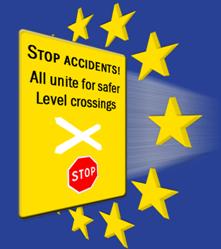How everything started: On the basis of already existing national campaigns to aware the public on the dangers at and around the level crossings, ELCF (European Level Crossing Forum) and UIC (International Union of Railways) decided to launch the first ever European Level Crossing Awareness campaign that took place on 25th June 2009.
Our first logo
Each year people die in accidents at level crossings. They represent at least in Europe around 1.2% of all road fatalities but a fourth of all rail accidents. It is statistically clear that most of the accidents that occur at level crossings are caused by road users and pedestrians mainly because of their misbehaviour. However, society still regards these fatal accidents only as a rail problem. This is a significant risk area for the rail sector while seen as a small element for road safety; consequently the balance must be redressed by recognising the bimodality of the issue.
Various initiatives have occurred over the past years to tackle this issue such as the DG TREN report of December 2003 “Safety at Level Crossings”, ERA reports, the 10th World Level Crossing Safety Symposium at UIC HQ in Paris in June 2008, the 12th Edition LX Symposium in Tokyo in 2010 and soon the 13th Edition in London in October 2012 as well as several national campaigns and days of action.
The informal group called ELCF that has brought since 2005, together rail and highway safety experts to exchange information and provide experiences to improve safety and performance of the level crossings, agreed on the constant need to focus on 3 main targets to achieve the goal of zero death at level crossings: the engagement of all stakeholders, a correct enforcement and education. Therefore, ELCF decided to organise ELCAD, the European Level Crossing Awareness campaign to inform the public on the dangers of the road/rail interface. The event benefited from large media coverage not only in Europe but also in other countries worldwide: A press book was made on this media impact , 90 TV and 67 radio interviews, 188 newspaper and 82 online articles.

